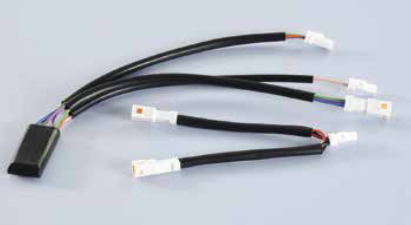
Véhicules garantis de 1 à 2 ans selon marque et modèle
Nos experts sont là pour vous 6/7j
au 05 62 26 31 64
Le kit de débridage POLINI HI-Speed est un dispositif électronique étudié pour les vélos à assistance électrique équipés de moteur YAMAHA PW-SYNC DRIVE (2015-2016) - YAMAHA PWX-SYNC DRIVE PRO (2017) - YAMAHA PWX-X2 (2020) - non compatible avec le modèle PW-ST (2023).
Ce kit permet de débrider la vitesse du moteur d'origine de 25 Km/h jusqu’à 50 km/h en augmentant l’assistance active et en exploitant au maximum les performances que le moteur peut offrir.
L’installation peut être réalisée aisément en quelques minutes. Les connecteurs s’intercalent directement avec ceux d’origine, en préservant leur capacité optimale de résistance à l’eau.
Ce kit est totalement invisible et s'insère naturellement à l'intérieur du cadre ou du compartiment moteur prévu à cet effet. Totalement réversible, la configuration d’origine peut se remonter simplement en effectuant le débranchement du kit.


ACTIVATION DU HI-SPEED
A l’activation du Hi-Speed, l’écran affiche une valeur de 50 km/h environ (+/- 3km/h) pour 5/10 secondes.
A la désactivation du Hi-Speed, l’écran montre une valeur approximative de 25 km/h (+/- 3 km/h) pour 5/10 secondes.
Quand le Hi-Speed est actif, le tachymètre marquera toujours la moitié du Km/h de votre vitesse réelle et des Km parcourus.
Pour connaître la vitesse et les Km exacts, il suffit de doubler seulement les valeurs. Certains modèles de vélo ne peuvent pas atteindre les 50 km/h en raison de limitations dues aux pignons montés.
Attention : certains écrans ne disposent pas d’affichage allumé/éteint. Pour allumer ou éteindre le dispositif Hi-Speed, le bouton d’éclairage doit être activé ou désactivé.
Le POLINI Hi-Speed a été développé avec les versions software des E-Bikes publiés à la date d’achat. Avec la mise à jour du micrologiciel des E-Bikes, le Hi-Speed pourrait générer des erreurs ou être endommagé permanentement par les dispositifs anti-tuning présents sur certains moteurs. Dans ce cas l’Hi-Speed ne sera pas couvert par la garantie et nous déclinerons toute responsabilité.
La mise à jour de l’E-Bike est permise seulement après l’enlèvement de l’Hi-Speed, mais son fonctionnement ne sera pas garanti.
Se monte exclusivement sur les VAE à moteur YAMAHA PW-SYNC DRIVE (2015-2016) - YAMAHA PWX-SYNC DRIVE PRO (2017) - YAMAHA PWX-X2 (2020) - non compatible avec le modèle PW-ST (2023).
Ref : 950.830.039
A LIRE ATTENTIVEMENT
L'utilisation de ce dispositif est réservée à un usage sur terrain privé ou en compétition.
Il est interdit d’utiliser un kit de débridage pour un usage routier ou dans toute zone soumise aux règles du code de la route.
ELECTRIK BIKE décline toute responsabilité en cas de violation du code de la route ou de dommages matériels et/ou corporels résultants de l’utilisation d’un kit de débridage pour vélo électrique.
Risques encourus en cas de débridage :
>> Défaut d'homologation
La circulation sur la voie publique d'un vélo équipé d'un kit de débridage est interdite. Outre un risque d'amende ou de saisie du véhicule, le risque principal est celui de l'engagement de la responsabilité de l'utilisateur avec reconnaissance des tords en cas d'accident.
>> Sécurité
Rouler avec un kit de débridage au-delà de 25 km/h augmente le facteur risque pour la sécurité du cycliste. La réglementation catégorie vélo homologué 45km/h impose le port d'un casque homologué ainsi que le port de gants.
>> Garantie constructeur
En cas de demande de prise en charge de garantie d'un élément électrique défectueux, le fabricant pourrait faire valoir une exclusion de garantie en cas de vérification de la pose d'un kit de débridage.
|
Kit de débridage POLINI Hi-Speed - YAMAHA PW-PWX-X2-SYNC DRIVE PRO
|
Ajouter au panier |